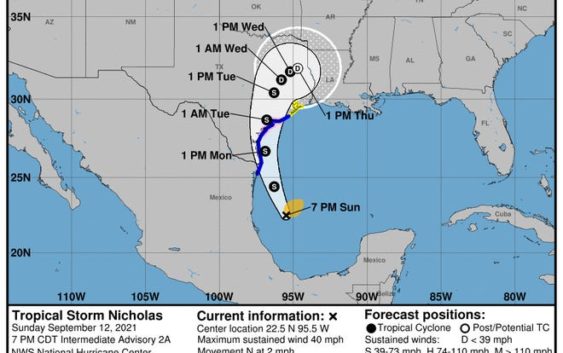- National memorial to honor NC firefighter who died on duty during Hurricane Helene
- Gov. Josh Stein extends State of Emergency for western NC wildfires
- Gov. Stein extends state of emergency for NC wildfire threat
- Governor Stein extends state of emergency for NC wildfire threat
- Governor Stein extends emergency in 34 NC counties amid wildfire threat
Hurricane Nicholas could cause life-threatening storm surge; see latest forecast here

The National Hurricane Center is reporting that Huricane Nicholas could bring life-threatening storm surge to the Texas coast as it makes landfall.
The storm is located 45 miles southwest of Freeport, and is moving north northeast at 10 mph. Weakening is anticipated as it moves onshore late Monday night or early Tuesday morning.
Here’s what we know.
Track the storm:Hurricane Nicholas threatens Texas: Follow the storm, spaghetti models
Nicholas storm surge threat in Texas
According to the NHC, the Hurricane Watch south of Port O’Connor is discontinued and the Tropical Storm Warning south of Port Aransas is discontinued. The Hurricane Watch from Port O’Connor north to Freeport has been upgraded to a Hurricane Warning.
The storm could bring rains of 6 to 12 inches, with isolated maximum amounts of 18 inches, across portions of the middle and upper Texas coastal areas through Wednesday. Interior southeast Texas and parts of Louisiana and Mississippi could see rainfall totals from 4 to 8 inches. The storm rainfall could cause considerable flash and urban flooding.
Residents who live in those areas should follow instructions given by their local officials.
Live:Watch live webcam as Hurricane Nicholas moves up the Gulf coast
How high might the storm surge get?
The water could reach the following heights above ground somewhere in the indicated areas if the peak surge occurs at the time of high tide, according to NHC:
- Port O’Connor to High Island: 3-5 feet
- Matagorda Bay and Galveston Bay: 3-5 feet
- High Island to Rutherford Beach, LA: 2-4 feet
- Port Aransas to Port O’Connor: 2-4 feet
- Aransas Bay and San Antonio Bay: 2-4 feet
- Rutherford Beach, LA to Intracoastal City, LA: 1-3 feet
- Sabine Lake and Calcasieu Lake: 1-3 feet
- Baffin Bay to Port Aransas: 1-3 feet
- Corpus Christi Bay: 1-3 feet
- Mouth of the Rio Grande to Baffin Bay:1-2 feet
Expect to see the deepest waters along the immediate coast, where the surge will be accompanied by large and dangerous waves.
What to expect:Tropical Storm Nicholas: How much rain, flooding is expected for South Texas?
What is storm surge? Here’s the definition
Storm surge is an abnormal rise of water generated by a storm, over and above the predicted astronomical tides, according to National Hurricane Center.
Storm surge should not be confused with storm tide, which is defined as the water level rise due to the combination of storm surge and the astronomical tide.
This rise in water level can cause extreme flooding in coastal areas, particularly when storm surge coincides with normal high tide, resulting in storm tides reaching up to 20 feet or more in some cases.
Alesha Williams Boyd contributed to this report.